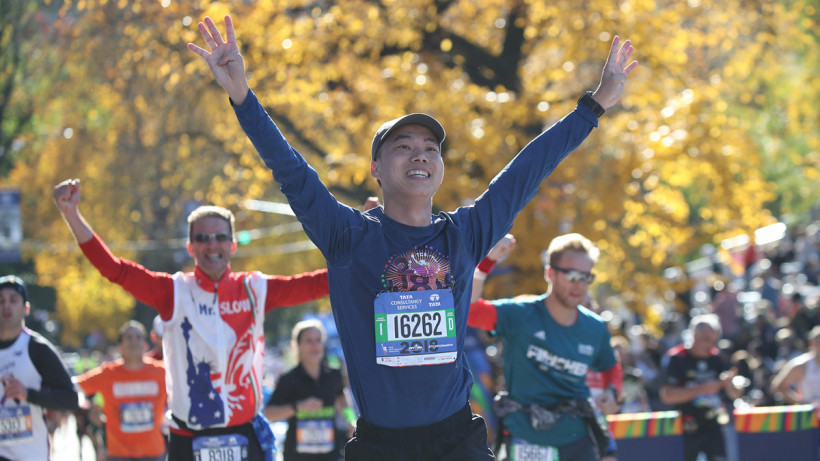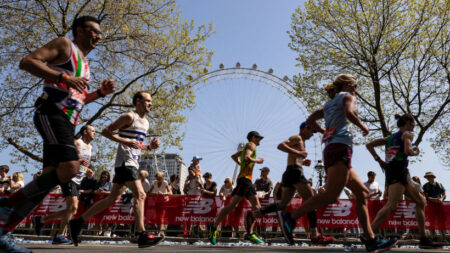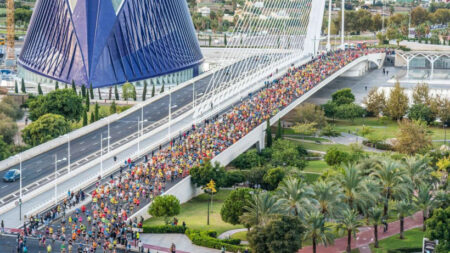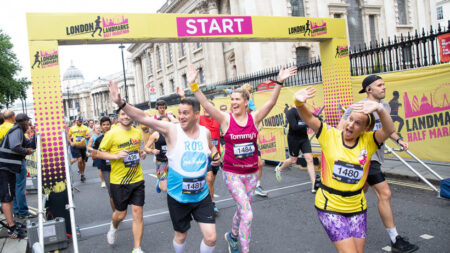Insider advice on the world's biggest road marathon
Big city marathons don’t come much bigger than the cinematic 26.2 miles around the streets of the Big Apple. One of the six World Marathon Majors and one of the biggest dates on the road-running calendar, the New York Marathon is a bucket list-level running adventure.
Note: The entry process mentioned in this article largely relates to the 2019 New York Marathon. Entry for this event is now largely closed. The article will be updated for the 2020 event.
Running through all five boroughs of the city – Staten Island, Brooklyn, Queens, The Bronx and Manhattan – is epic enough, but when you throw in some of the largest and loudest crowds along the way, what you get in New York is so much more than a medal. This is a marathon – and a weekend – turned up to 11.
That said, wrestling with the logistics of running a race in a city as sprawling as New York can be a tad daunting. But we’re here to help. From how to enter, to the tips and tricks to make your NYC adventure run smooth, our resident marathon runner and New York Marathon finisher, Kieran Alger, rounds up everything you need to know to nail your run in NYC.
How to get a place
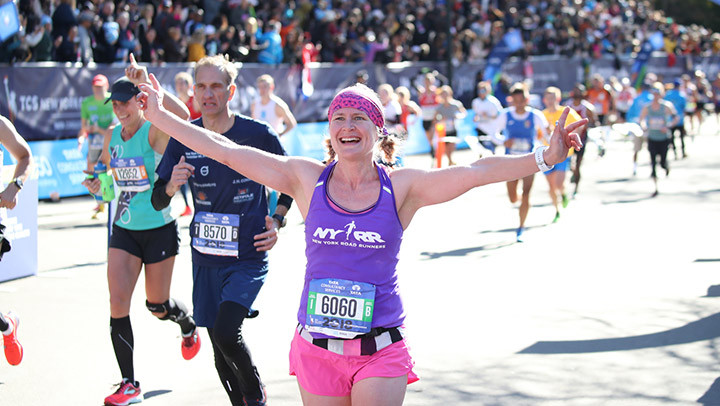
Just like London, Tokyo, and Berlin, the New York Marathon is hugely oversubscribed. Despite being the biggest world marathon with a whopping 52,812 finishers in 2018, the fight for a place is fierce.
In 2019, a record 117,709 applicants registered for entry in the ballot with just 10,510 accepted. That’s less than 10 per cent so you have to be lucky to land a scarce ballot spot. In fact, getting into the race is probably harder than actually running it.
There are ways to guarantee your place on the Staten Island start line, though
Book a tour: The easiest but not necessarily cheapest route for international runners into the New York Marathon is to sign up for an official tour package. These guarantee you a place in the race and, depending on your budgets and preferences, can cover flights and accommodation too.
There are localised tour operators around the world with the two official operators for the UK being Sports Tours International and 209 Events.
Prices for packages range from £1,018 for hotel and guaranteed entry, right up to £4,248 for a full package that includes flights as well. How much you pay will also depend on your hotel of choice, whether you’re happy to share a room and how long you decide to stay in New York.
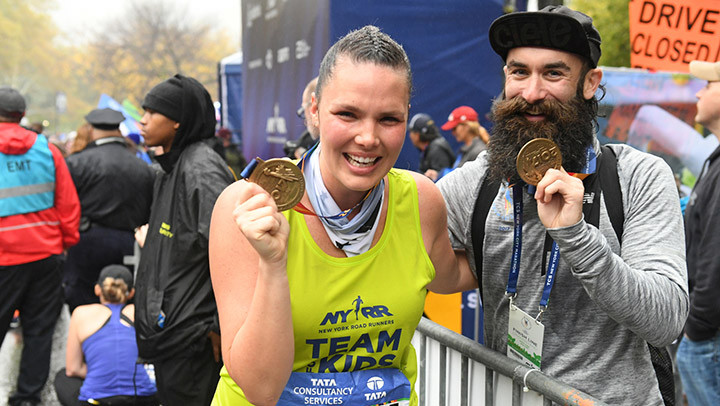
Run for charity: Each year thousands of places are sold to charities who can then allocate them to runners. You’re required to commit to a minimum fundraising target and these vary from charity to charity – but expect this to be in the thousands of pounds.
Each year a full list of charity partners is published on the official website on the day the ballot results are revealed.
Run a qualifying time: If you’re fast enough, you can bag a qualifying spot – but the bar in New York is set high. Also, the majority of qualification places go to runners who’ve run the requisite times in races mainly in the US, while only a limited number of spots go to runners who hit the target times on courses elsewhere.
Full information on the qualifying times for the 2019 marathon can be found at the end of this article.
The window for running a qualifying time for the 2020 TCS New York City Marathon is 1 January-31 December 2019.
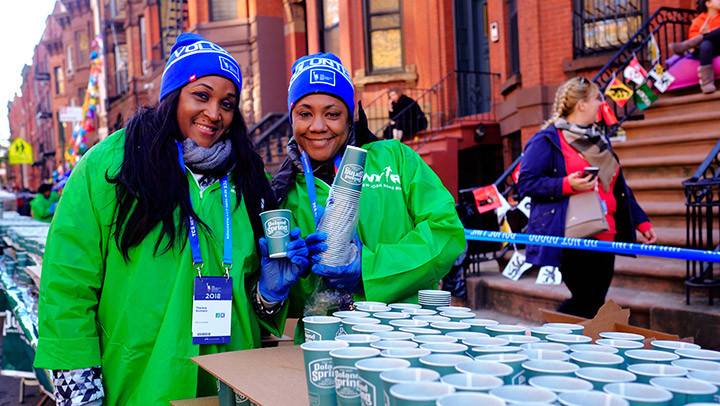
Complete the NYRR 9+1 program: Another entry route that favours locals. If you clock up nine finishes in NYRR races throughout the year and volunteer at one, your loyalty and commitment to the local running scene can earn you a New York bib. Details of the program can be found here.
How much does it cost to enter the New York Marathon?
How deep you’ll have to reach into your pockets depends on how you choose to enter, where you come from and if you’re a member of the New York Road Runners (NYRR).
Entry into the New York Marathon ballot is free but if you’re one of the lucky few to land a spot (only 15% of the 105,000 hopefuls bagged a place in 2018), it’s $295 for non-NYRR members, $255 for members, and $358 for runners living outside of the U.S.A.
Where’s the best place to stay?
As you’d expect in one of the world’s biggest cities, the accommodation options for New York are vast. From airbnb to 5-star luxury hotels from Brooklyn to Manhattan, the choice can be bewildering.
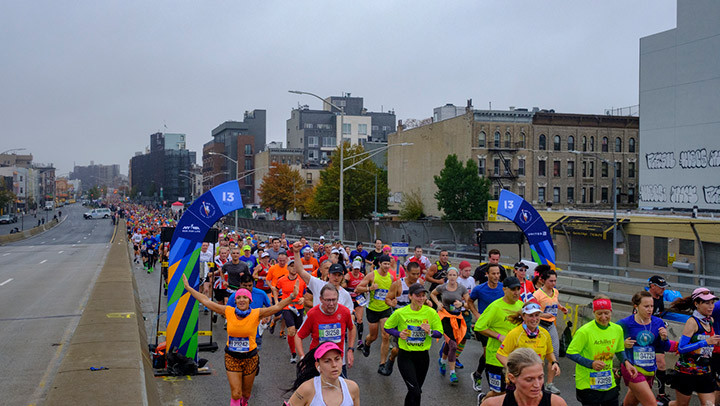
Unlike other city marathons, New York’s point-to-point set up means it isn’t a race where it’s possible to find accommodation that’s a wobble away from the start and finish. In fact, it’s probably better to think about your accommodation location in terms of your whole trip to the city, rather than making sacrifices just for the run.
Transport is going to be tricky no matter what and to a certain extent, you just have to suck it up. You’ll definitely have to travel to the start and more than likely face a trek back after the race.
That said, there are areas where it’s slightly easier to access the transport to the start and having a hotel near Central Park and the finish might appeal to some.
Prices for hotels tend to skyrocket over marathon week so most people opt for locations in the surrounding boroughs. Brooklyn offers one of the best locations based on price, location and quality of accommodation – although expect at least a half-hour subway journey to get to your public transport in the morning.
The expo
As with the majority of race expos, the New York Marathon expo is located nowhere near the start or the finish of the actual race. Luckily, unlike London, it takes place relatively close to central Manhattan. The full address is: Jacob K. Javits Convention Center, Halls 3B and 3E, 11th Avenue at West 35th Street. Store that in your phone somewhere.
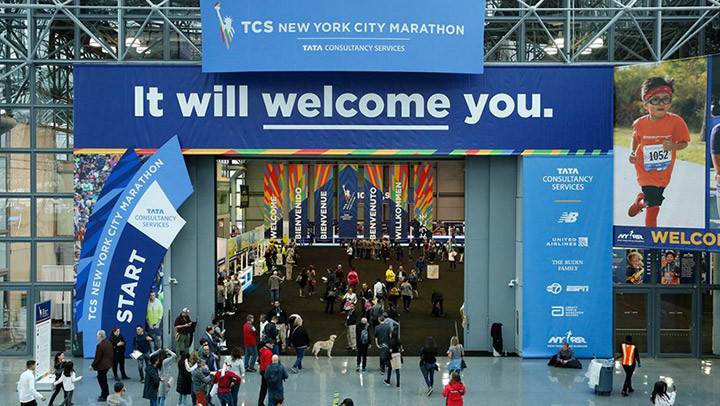
As expos go, it’s the largest in the country with over 130 vendors selling running-related kit and nutrition. Obviously, you wouldn’t do anything as stupid as buying new kit for a marathon you’re doing in a couple of days, but you are likely to find a bargain or two if you look around.
Here you’ll also pick up your race pack, carrier bag, your timing chip and various other bits and pieces. Remember to bring your marathon entry proof and your ID.
Getting to the start
Getting to the start line for the New York Marathon is more challenging than most big-city marathons. The race starts at Fort Wadsworth on Staten Island, a 60-90 minute bus or bus and boat ride away from most of the city.
And with the first wave starting at 8.30am and the final wave going off at 11am, you’re guaranteed an early start.
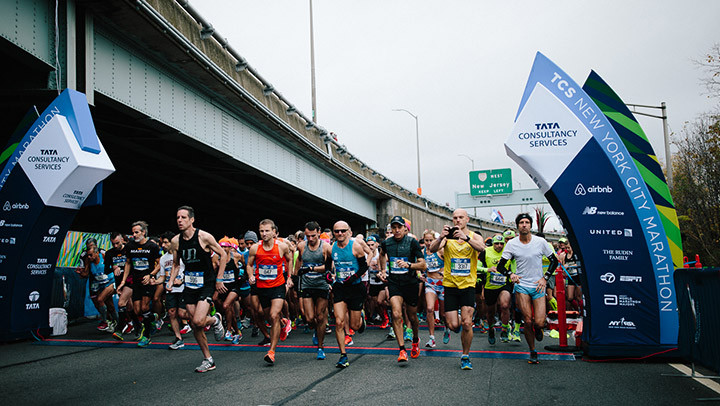
If you’re coming from the UK and Europe, depending on how long you’re in New York before the race, it’s almost worth trying to keep your body clock on your home time where you tend to wake around 3-4am anyway. This can soften the blow of that brutal early morning trek to Staten Island.
Unless you’re part of a tour that’s already laying on transport, by far the best way to reach the Staten Island start line is on the official transport. But be warned, this fills up fast and registration closes early in September each year.
Depending on where you’re staying, you’ve got three options:
Staten Island Ferry
Where: Whitehall Terminal, Manhattan
Journey time: 90 minutes
Whitehall Terminal is accessible by several MTA subway and bus routes. The free ferry transports runners to St. George Terminal on Staten Island, from which free buses transport runners to Fort Wadsworth.
Midtown Manhattan Bus
Where:New York Public Library, Fifth Avenue at 42nd Street
Journey time: 90 minutes
Buses transport runners directly to Fort Wadsworth. The New York Public Library is centrally located and accessible by many subway and bus routes.
New Jersey Bus
Where:MetLife Stadium Parking Lot K, by the Quest Diagnostics Training Center
Journey time: 60 minutes
Buses transport runners from MetLife Stadium Parking Lot K directly to Fort Wadsworth. There is no parking at this location.
Failing these, you can travel by private vehicle but there are serious restrictions on the roads and you can expect nightmarish traffic and general mayhem. Not many go for that option.
What’s the start village like?
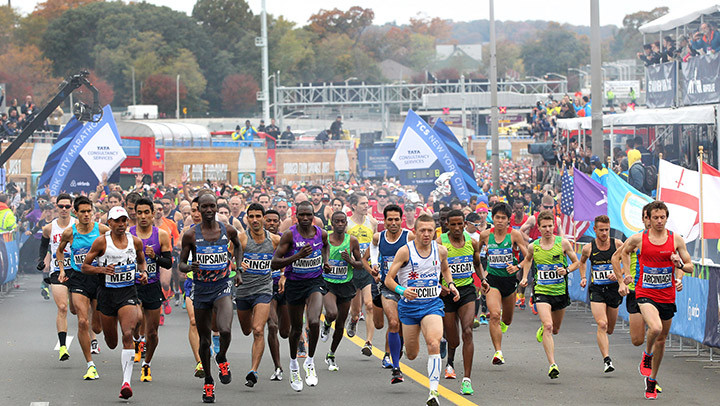
Once you’ve made it, New York Marathon start village is buzzing as people pile off buses and the cops usher them into the busy start village. Spectators aren’t allowed to travel to the start so at this point it’s runners only. You can also only take the official race bag given to you at the Expo into the race village so everything you need will have to squeeze into that.
The village areas is awash with a mixture of excitement and tension. People snapping selfies, snaffling free bagels and coffee, queuing for portaloos and desperately trying to stay warm.
And that’s the crucial thing here, warmth. If there’s one tip to remember it’s to take warm clothes, blankets, hats, gloves and whatever you can carry and are willing to drop into a charity bin at the start.
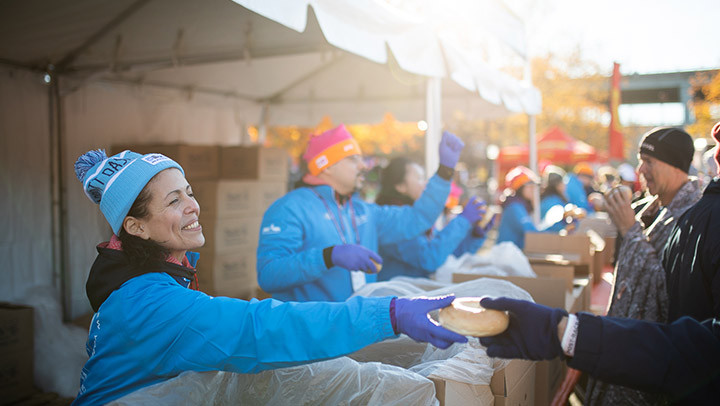
Even if the November weather forecast suggests otherwise, it will be colder than you expect it to be. You will likely be standing around for at least two hours before you start, and there’s very little shelter and no seating.
Some people even take lilos and inflatables for temporary seating and sleeping bags. Don’t be the runner turning blue in short shorts and a vest. Keep some layers on even in the starting pen and discard them as you creep to the start line.
Another piece of advice from one runner who has made this mistake: Don’t be tempted to eat ALL THE BAGELS, even though they look great and they’re free.
The New York Marathon course
There are a few things that everyone talks about when it comes to the New York Marathon. The bridges, the support and that Central Park finish.
Bridges = Hills
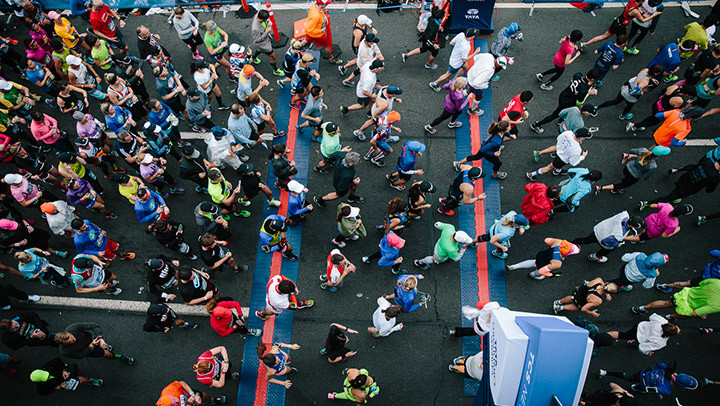
Let’s talk bridges first. And by bridges what we really mean are hills. There are five bridge crossings in total. The two biggest being the Verrazzano – which connects Staten Island to Brooklyn at the start – and the Queensboro/59th Street Bridge, which comes at mile 14-16.
Both span nearly two miles. These are not flat. In fact, they are the worst kind of hills, the long, slow gradual type that trick you into thinking you can keep up your target pace without doing any damage. You can’t. Treating these with respect and easing off the pace will pay off.
The Verrazzano Bridge also has two tiers and runners cross on both. If you’re running the lower tier it’s advisable to stay in the middle of the road to avoid getting a urine shower from the runners above who failed to beat the portaloo queues and take the first opportunity to unleash their bladder burden.
The Central Park pain barrier
The Verrazzano will be a distant memory by the time you enter Central Park at the other end of the race. But another really important thing to factor into your race plan is that this is pretty hilly for a city marathon.
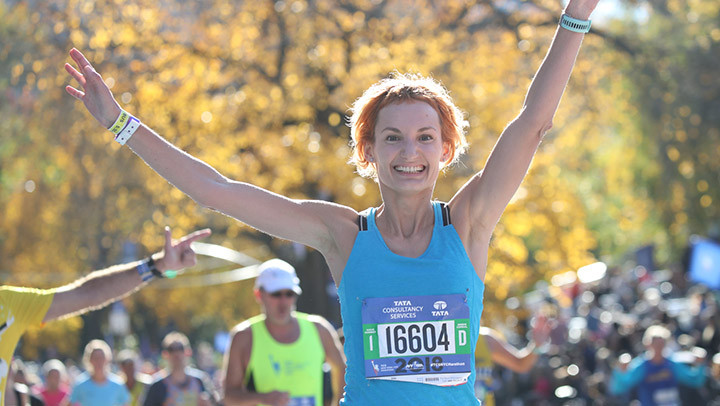
According to MapMyRun stats, the total elevation gain for New York is 260 metres. By contrast, the London Marathon has just 180 metres.
The miles from 24 to the finish feature the biggest hills in the whole race. If you’re expecting an easy run to the finish line, these climbs can really hammer your spirit and hurt those heavy legs.
That’s where the famous New York crowds really kick in. There’s huge support throughout the 26.2 miles but the deafening cheers as you snake around Central Park praying for the finish line to be round the corner or over the brow of the next hill, will play a huge part in getting you through.
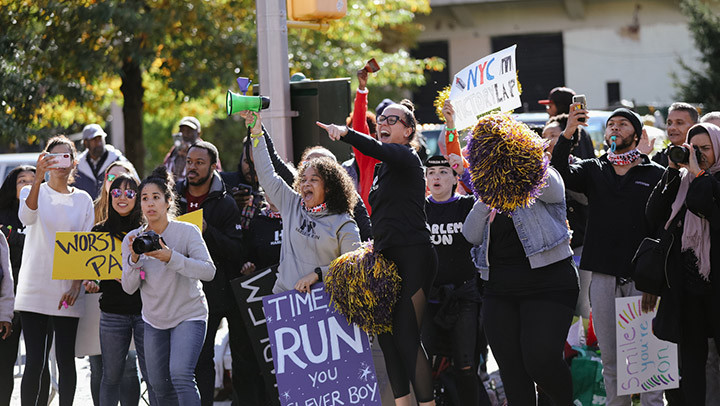
Dire straights
One thing no one ever mentions about New York are the long, long straights. Coming off the Queensboro Bridge, for example, after a few twists and turns you’re spat out onto First Avenue. Up ahead, disappearing into the distance is around 7km of non-stop straight trudge, right at a point when the race can start to bite.
The finish
When you cross the finish line of the New York Marathon, unfortunately, your work isn’t done. The zombie walk to escape Central Park can be at least another mile. Your battered body – and the congestion – can make that a very slow mile indeed.
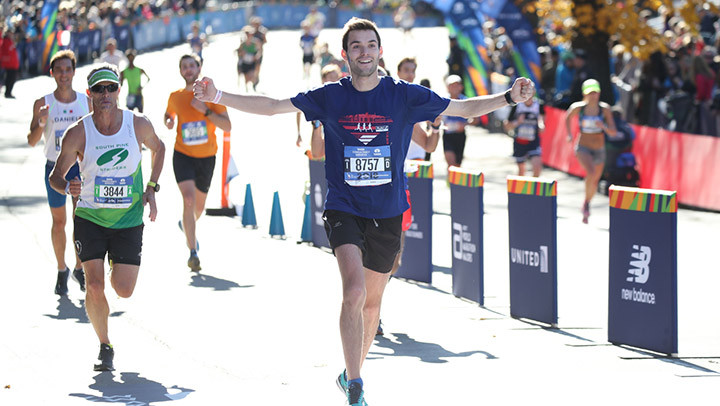
Where you exit is also dictated by whether you checked a drop bag at the start and your bib number. If you dropped a bag at the start, you’ll be directed to reclaim and then leave Central Park by the Bag Check exits, located at West 81st Street and West 85th Street.
If you decided not to bother with a bag, you’ll be ushered to the Post-Race Poncho exit at West 77th Street and be handed a foil blanket to wrap yourself up like a turkey.
Should you check a bag?
It can get cold very quickly post-race and difficult to get transport away from the finish, so a change of clothes feels sensible. However, the baggage queues can also be crazy busy. So it’s a toss-up between getting out of there fast or queueing to get your warm, dry clothes. Either way, you’re likely to get cold.
When you finally break free from the park, being spat out onto the streets of this big city with a post-marathon head on can be very daunting. You can ask family and friends to meet you in the post-race corrals. These start from Z and go up to A so regardless of your name it’s smart to meet lower down the alphabet to save yourself a stroll.
It’s also smart to arrange a location away from the race finish but close enough to hobble to, where you can hole up, grab a drink and some food and wait for the marathon madness (the city’s and your own) to die down.
Plus, wander into most bars and cafes wearing your medal walking like a wounded soldier and you’re guaranteed a New York-style heroes welcome. That goes for later in the evening and the following day too.
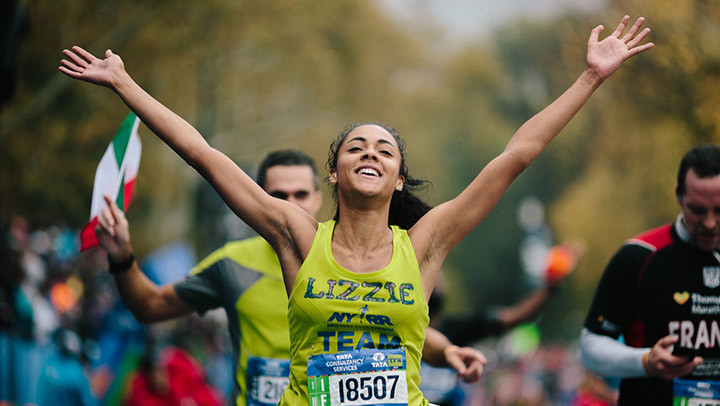
Average finish times
The women’s New York marathon course record is 2:22:31 while the men’s is 2:05:05. Both are a long way outside the world records at this distance and that tells you a lot about how tough this is compared to other marathon courses.
The average finish time for the New York Marathon in 2018 was 4:38:24.
Qualifying times
Men’s Standards:
| Age* | Marathon | Half-marathon |
| 18-34 | 2:53:00 | 1:21:00 |
| 35-39 | 2:55:00 | 1:23:00 |
| 40-44 | 2:58:00 | 1:25:00 |
| 45-49 | 3:05:00 | 1:28:00 |
| 50-54 | 3:14:00 | 1:32:00 |
| 55-59 | 3:23:00 | 1:36:00 |
| 60-64 | 3:34:00 | 1:41:00 |
| 65-69 | 3:45:00 | 1:46:00 |
| 70-74 | 4:10:00 | 1:57:00 |
| 75-79 | 4:30:00 | 2:07:00 |
| 80+ | 4:55:00 | 2:15:00 |
Women’s Standards:
| Age* | Marathon | Half-marathon |
| 18-34 | 3:13:00 | 1:32:00 |
| 35-39 | 3:15:00 | 1:34:00 |
| 40-44 | 3:26:00 | 1:37:00 |
| 45-49 | 3:38:00 | 1:42:00 |
| 50-54 | 3:51:00 | 1:49:00 |
| 55-59 | 4:10:00 | 1:54:00 |
| 60-64 | 4:27:00 | 2:02:00 |
| 65-69 | 4:50:00 | 2:12:00 |
| 70-74 | 5:30:00 | 2:27:00 |
| 75-79 | 6:00:00 | 2:40:00 |
| 80+ | 6:35:00 | 2:50:00 |
*Age on November 1, 2020, for the 2020 TCS New York City Marathon.
Main image credit: New York Road Runners


